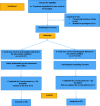The effect of online multimedia psychoeducational interventions on the resilience and perceived stress of hospitalized patients with COVID-19: a pilot cluster randomized parallel-controlled trial
- PMID: 33573631
- PMCID: PMC7877318
- DOI: 10.1186/s12888-021-03085-6
The effect of online multimedia psychoeducational interventions on the resilience and perceived stress of hospitalized patients with COVID-19: a pilot cluster randomized parallel-controlled trial
Abstract
Background: There is evidence suggesting that quarantine might have undesirable psychological impacts on the patients. Therefore, it is important to seek for ways to increase the resilience and alleviate the psychological pressure of the patients who are quarantined due to infection with COVID-19. The present study was conducted to assess an online multimedia psychoeducational intervention regarding the feasibility, adherence, patient satisfaction and effectiveness on resilience and perceived stress of patients hospitalized with confirmed COVID-19.
Method: This was a pilot cluster randomized parallel-controlled trial with hospital wards as the units of randomization. Participants in this fully online trial were 50 consecutive patients who were hospitalized in 2 hospitals in Shiraz, after being diagnosed with COVID-19. Before the beginning of the intervention, four inpatient wards inside two of the hospitals were randomly assigned to either intervention or control conditions. All eligible participants in the wards allocated to the intervention condition received online multimedia psychoeducational interventions during the 2 weeks, whilst the patients in the wards allocated to the control condition were offered the opportunity to receive telephone-based psychological counseling if needed. Psychoeducational interventions mainly included cognitive-behavioural techniques, stress management techniques, mindfulness-based stress reduction and positive psychotherapy. The patients were assessed regarding resilience and perceived stress at baseline and after two weeks.
Results: Of 27 patients starting multimedia psychoeducational interventions, 26 (96.29%) completed post-assessments. A high level of adherence (80.76%) and satisfaction (Mean = 29.42; SD = 4.18) with the online multimedia psychoeducational interventions was found. Compared with the control group, the patients who used online multimedia psychoeducational interventions reported greater resilience (Meanintervention = 81.74; Meancontrol = 72.86; adjusted t (46) = 2.10; p = 0.04; CI: 0.39 to 17.38; dppc2 = 0.83) and fewer perceived stress (Meanintervention = 22.15; Meancontrol = 29.45; adjusted t (46) = 2.66; p = 0.01; CI: - 12.81 to - 1.78; dppc2 = - 0.77) after 2 weeks.
Discussion: The findings of the present study provided a successful first attempt at implementing feasible online multimedia psychoeducational interventions to promote resilience and mitigate stress among the patients who were hospitalized due to infection with COVID-19. The present results could help mental health professionals to determine which psychological techniques should be emphasized to promote patients' resilience in the context of COVID-19 disease.
Trial registration: Iranian Registry of Clinical Trials, IRCT20201001048893N1 . Retrospectively registered, 29 Jan 2021.
Keywords: COVID-19; Online multimedia psychoeducational intervention; Perceived stress; Resilience.
Conflict of interest statement
The authors declare that they have no competing interests.
Figures
Similar articles
-
An internet-based self-help intervention for people with psychological distress due to COVID-19: study protocol for a randomized controlled trial.Trials. 2021 Mar 1;22(1):171. doi: 10.1186/s13063-021-05089-9. Trials. 2021. PMID: 33648555 Free PMC article.
-
Effectiveness of a Web-Based Self-Guided Intervention (MINDxYOU) for Reducing Stress and Promoting Mental Health Among Health Professionals: Results From a Stepped-Wedge Cluster Randomized Trial.J Med Internet Res. 2025 Feb 3;27:e59653. doi: 10.2196/59653. J Med Internet Res. 2025. PMID: 39899345 Free PMC article. Clinical Trial.
-
The effectiveness of multimedia mental health self-care program based on cyber space on the mental health of infertile women: a randomized controlled trial.BMC Psychol. 2024 Nov 12;12(1):647. doi: 10.1186/s40359-024-02139-0. BMC Psychol. 2024. PMID: 39533352 Free PMC article. Clinical Trial.
-
Psychological interventions to foster resilience in healthcare professionals.Cochrane Database Syst Rev. 2020 Jul 5;7(7):CD012527. doi: 10.1002/14651858.CD012527.pub2. Cochrane Database Syst Rev. 2020. PMID: 32627860 Free PMC article.
-
Web-based interventions on the resilience of informal caregivers: a systematic review and meta-analysis.Psychol Health Med. 2024 Jan-Jun;29(1):1-14. doi: 10.1080/13548506.2023.2253510. Epub 2023 Sep 7. Psychol Health Med. 2024. PMID: 37676014
Cited by
-
Resilience and Wellbeing Strategies for Pandemic Fatigue in Times of Covid-19.Int J Appl Posit Psychol. 2023;8(1):1-36. doi: 10.1007/s41042-022-00078-y. Epub 2022 Sep 30. Int J Appl Posit Psychol. 2023. PMID: 36196257 Free PMC article. Review.
-
The effect of mobile-based logotherapy on depression, suicidal ideation, and hopelessness in patients with major depressive disorder: a mixed-methods study.Sci Rep. 2023 Sep 22;13(1):15828. doi: 10.1038/s41598-023-43051-8. Sci Rep. 2023. PMID: 37740006 Free PMC article.
-
Effectiveness of online mindfulness interventions on medical students' mental health: a systematic review.BMC Public Health. 2021 Dec 18;21(1):2293. doi: 10.1186/s12889-021-12341-z. BMC Public Health. 2021. PMID: 34920715 Free PMC article.
-
The reverse buffering effects of social support on the relationships between stresses and mental health: a survey of Chinese adults during the COVID-19 lockdown.Eur J Psychotraumatol. 2021 Aug 10;12(1):1952777. doi: 10.1080/20008198.2021.1952777. eCollection 2021. Eur J Psychotraumatol. 2021. PMID: 34408816 Free PMC article.
-
Depression and Anxiety During the COVID-19 Pandemic: Epidemiology, Mechanism, and Treatment.Neurosci Bull. 2023 Apr;39(4):675-684. doi: 10.1007/s12264-022-00970-2. Epub 2022 Nov 21. Neurosci Bull. 2023. PMID: 36411394 Free PMC article. Review.
References
-
- Mazza MG, De Lorenzo R, Conte C, Poletti S, Vai B, Bollettini I, Melloni EM, Furlan R, Ciceri F, Rovere-Querini P, Benedetti F. Anxiety and depression in COVID-19 survivors: Role of inflammatory and clinical predictors. Brain Behav Immun. 2020;89:594–600. doi: 10.1016/j.bbi.2020.07.037. - DOI - PMC - PubMed
Publication types
MeSH terms
Grants and funding
LinkOut - more resources
Full Text Sources
Other Literature Sources
Medical




